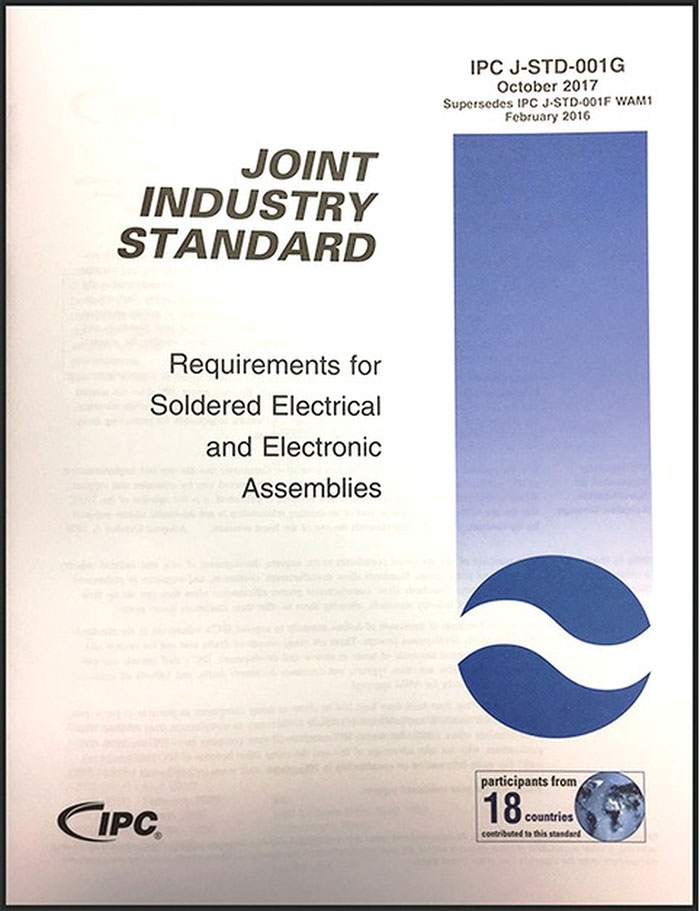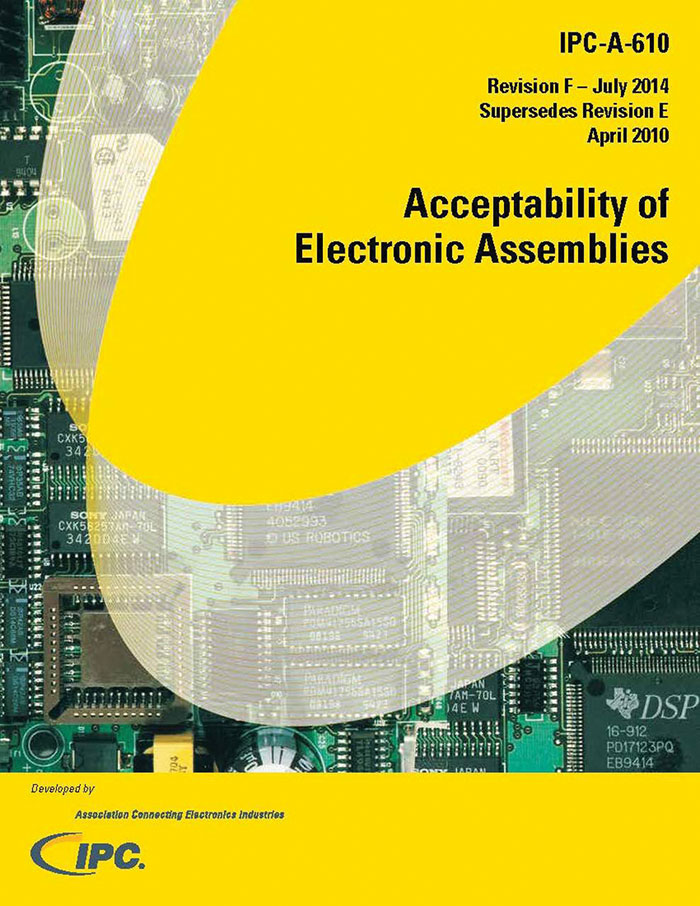Training to the Requirements of IPC Specifications
Given frequent updates, the certification program can be confusing to new users.
IPC training programs are designed to help students develop an understanding of manufacturing and inspection programs to fabricate, manufacture and inspect the product to meet the needs of the customer. This article, based on a workshop I developed, discusses J-STD-001, Requirements for Soldered Electrical and Electronic Assemblies and some elements I find problematic in understanding the criteria.
Scope of presentation. J-STD-001 is written in two segments. The process section includes equipment controls, material selection and requirements of the facility environment. It also discusses the methodology of how work areas are to be designed and controlled environmentally, such as lighting, temperature, humidity and ESD protection. (Although these are areas of concern to the manufacturing facility environment, operators have little to do with their implementation.)
This section also includes verification of material such as flux, solder and solder paste, and subsequently the section entails the requirements of material qualification and references those specific specifications to accomplish those tasks. The importance of meeting these requirements is exposed during an audit from the contracting authority, and if proof of due diligence is not properly demonstrated or documented, the product can be rejected as having been built with nonqualified materials. This is an expensive oversight, especially when it causes product delivery to miss the customer’s timelines or expectations.
The second part of the document details various styles of solder connections demanded by the types of components used in electronics products. This portion is segmented into four sections: wires and terminals, plated through-hole technology, surface mount technology, and inspection of the physical solder joints. Each section includes both the theory of the process and workmanship demonstrations of the specific technology.

Figure 1. IPC-J-STD-001 details the physical act of assembling and soldering.
Faster update cycle. The introduction of new materials and component configurations in the industry changes the technology and product demands, which in turn prompt additional changes to the specifications and training documentation. Hence, to accommodate these changes and be more responsive to the customer, IPC has shortened the document update schedule to three years from the previous five-year span. As a result of this change in schedule, there is an impact to the participants using the documents, the individuals contributing the technical expertise, and the members who physically review those documents prior to their release to the industry at large. It is important to understand volunteers perform IPC’s technical standards development, and these demands and participation require support of their respective companies.
From a training perspective, one of the confusing element interpretations in this process is for customers to decide which class to take. The typical options are based on either J-STD-001 or IPC-A-610. IPC-A-610, Acceptability of Electronic Assemblies sets forth inspection guidelines and is designed for inspectors of electronic assemblies. J-STD-001 details the physical act of assembling and soldering a printed circuit board. Traditionally the customer builds product to J-STD-001 criteria and inspects the resultant product to the visual requirements of IPC-A-610.
To date, 311 pages of comments have been submitted to upgrade the current iteration of J-STD-001, known as Revision G, to Revision H. Some changes are small, such as correcting the artwork in the surface mount section or editorial changes to fix typos. There are new components and requirements for flat gullwing components. These comments originate from members who review and submit comments to the respective task group. This review is conducted all the way through the beta classes, held to review the new document information and make the appropriate corrections as demanded by either technical requirements or editorial elements.
Training focus. The process of teaching any of the courses may address the specific changes that have occurred with the revision changes of the document. The focus of training, however, is on the entire document, not just the changes. The programs are copyrighted documents. The soldering and acceptabity programs must be conducted in line with the train-the-trainer model for Certified IPC Trainers (CIT), which sets forth how to use the information for each program to in turn train Certified IPC Specialists (CIS) within their facility. The CIT programs cover the material in the respective documents and include additional criteria relative to teaching methodologies and how to prepare to present the course. Therefore, the certification processes are not revision-specific, which is defined by IPC, and they have rules and regulations on how to conduct the programs.

Figure 2. IPC-A-610 establishes inspection guidelines.
For example, here are a few of the most misunderstood elements of the document:
Terms and definitions. Learning the following terms and what they mean: discernible, overwrap, overlap, [A1A2A3] [D1D2D3] and components or applications with no Class 3 requirements [A1A2N3].
For example:
- Discernible is the ability to distinguish the existence of a wire within a solder joint.
- Overwrap is a condition of wrapping a wire around a post terminal more than 360°.
- Overlap is a defective condition when the wire being wrap around the post terminal is not in direct contact with the post itself.
The parenthetical terms [A1A2A3] and [D1D2D3] are the acceptable conditions (A) and defective conditions (D) shortcut terms applied to the stated requirements within the standard. If the statements within the specifications are met the appropriate designation is applied. An (N) term implies there are no requirements for that particular condition at this point in time, as most likely it has never been used and evaluated.
Understanding the definition of the requirements, especially for the differentiation of the various criteria of acceptable, process indicators, no requirements, and defective conditions. Many new students are from different cultures and have work experiences unrelated to the electronics industry. Introducing these new concepts, definitions and formats requires time from the programs to verify and check if these concepts are understood.
Conflict resolution. As J-STD-001 is written, it is very difficult to interpret the results of an inspection if the contract states the product will be built and inspected to the requirements of J-STD-001, as this document is a soldering document. The contract may or may not offer the opportunity to use another document to enhance the inspection of the product. Therefore, use of IPC-A-610 is not allowed unless it is specifically allowed by contract. The task group is working to change the existing revision to allow an inspection document to supplement and complement the inspection process.
Interpretation of the differences between a conductor and wire diameter, as this was a difficult concept to understand by many in the industry. This was added to the document as part of removing the ambiguity of the differences between a wire and conductor diameter. For many users, this is a difficult concept to grasp, yet the document did not specifically state the definitions of each.
The meaning of “objective evidence” is a problematic area to substantiate a point or criteria. The explanation is found in J-STD-001 Appendix C, “Guidance on Objective Evidence of Material Compatibility,” for example:
- Many contractors and contract assemblers need to verify the efficacy of the assemblers and others involved in manufacturing their products, and they need to know whether the contract manufacturer’s employees have the proper training to assemble their products.
- Second, any changes in the manufacturing processes or use of material may also require evidence of evaluation to substantiate their use on the customer’s products. This is a big issue with the use of conflict materials, as well as products and changes in existing materials acquired to manufacture the product.
- The need to qualify materials being used, or face rejection of the product because it was not built with qualified materials, is affected by this requirement.
The conversion to lead-free solders and other alloys and the due diligence to qualify those materials. Although this requirement changed in 2006, users still question differences required to solder with lead-free solder alloy. This also impacts the total time to conduct a class.
Physical soldering requirements. For new employees, the need for thermal profiles in the creation of the solder connections on the circuit board is a new concept to understand.
Moreover, there’s the actual solder connection. The most important part of the training program is to learn about flux, preheat and solder, and how all three must work together to create a solder joint. Second, there are manual soldering tools, how to use them, and proper protection procedures for safety purposes.
Other areas of confusion in this category include the definition of soldering a wire to a terminal and the new explanation of the visuals, and lead trimming and the impact of cutting leads after soldering.
As mentioned, these are just some of those topics. The task of training students must cover not only the subject material of the text, but areas of concern that could be difficult to interpret and comprehend.
is vice president and technical director at EPTAC Corp. (eptac.com); leo@eptac.com. He wrote the first IPC-A-600 training program and is a member of the IPC Hall of Fame.
Press Releases
- Altus Group Expands Aftersales Team to Its Largest Size to Date
- Incap Estonia Invests in New Flying robe System to Advance Production Performance
- Critical Manufacturing Partners with Canonical to Expand Cloud-Native Deployment Options for Manufacturers
- Heller Industries Becomes the Latest Partner to Join THE SMT FUTURE EXPERIENCE







